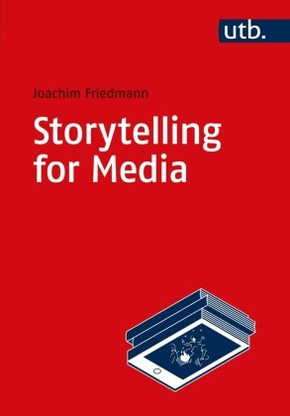
Storytelling for Media - Introduction to the Theory and Practice of Narrative Design
| Verlag | UTB |
| Auflage | 2021 |
| Seiten | 166 |
| Format | 15,5 x 1,2 x 21,5 cm |
| Gewicht | 264 g |
| Artikeltyp | Englisches Buch |
| ISBN-10 | 3825257649 |
| EAN | 9783825257644 |
| Bestell-Nr | 82525764A |
The term "storytelling" is gaining prominence both in academia and industry - rightly so - because narrative techniques allow for particularly effective and sustainable communication. Stories are what catch our attention, move us, teach us to empathise, and create strong memories. This introduction to the strategies of storytelling uses fundamental scientific texts as well as dramaturgical guides and practical examples. Dr. Joachim Friedmann, professor and writer of scripts for tv, comics, and games, presents a both theoretically-sound and practically-applicable guide for the analysis and design of narratives in various media, not only for students, but for everyone who wants to understand how stories are created.
Inhaltsverzeichnis:
1 Storytelling - More than Just Telling a Story2 The Narrative Figure - Life, Theme, Function2.1 Functional Figures2.2 Mimetic Figures2.3 Thematic Figures2.4 Anti-narrative Figures3 Setting - The Narrative Space3.1 Juri Lotman and Semantic Space3.2 Other Options for Spatial Semantization3.3 Hierarchization of Spatial Events4 Binary Narrative Oppositions - Opposites Make Sense4.1 The Meaning of the Narrative4.2 Production of Meaning through Binary Narrative Oppositions4.3 Idea vs. Counter Idea - Narrative Oppositions in Film Dramaturgy4.4 Binary Narrative Oppositions as a Structuring Principle in Serial and Interactive Narratives5 Conflict - Obstacles Force Action5.1 Conflicts as Initial Triggers for Action5.2 Basic Forms of Conflict5.3 The Universal Conflict5.4 Conflict Types and Types of Plot5.5 Want and Need6 Transformation - What Needs to Change?6.1 Transformation vs. Change6.2 Transformation as a Criterion of Closure6.3 The Cyclic Transformation6.4 Transformations in Interacti ve Narratives7 Emotion - Progression of Feelings7.1 Emotions as Genres7.2 Emotional Progression as a Structural Principle of Narratives8 Turning Points - the Expected Surprise8.1 Scientific Concepts of the Turning Point8.2 The Turning Point in Applied Dramaturgy8.3 The Effect of Turning Points in Literature and Film8.4 Turning Points and Transformation in Interactive Narratives9 Narrative Structure - The Hero's Journey in Three Acts9.1 Dramatic Structure9.2 Mythological Structure9.3 Oral Structure9.4 Interactive Structure10 Causal Relationships - Why and How?10.1 Causality as a Condition for Narrativity10.2 Forms of Causality10.3 Forms of Non-causal Narrative10.4 Causality and Interactivity11 Subtext and Gapping - Involving the Recipients11.1 Gapping as a Text- and Media-Specific Strategy11.2 Subtext11.3 Generating Tension through Information Management11.4 Information Management in Interactive Stories12 Semantic Objects - McGuffins, Horcruxes and Holy Grails12.1 Plot-functional v s. Non-functional12.2 Semantic Objects in Narrative Media12.3 The Semantization of Objects as a Communication Strategy13 Epilogue: Values and a Worldview14 Glossary15 Bibliography16 List of Figures
